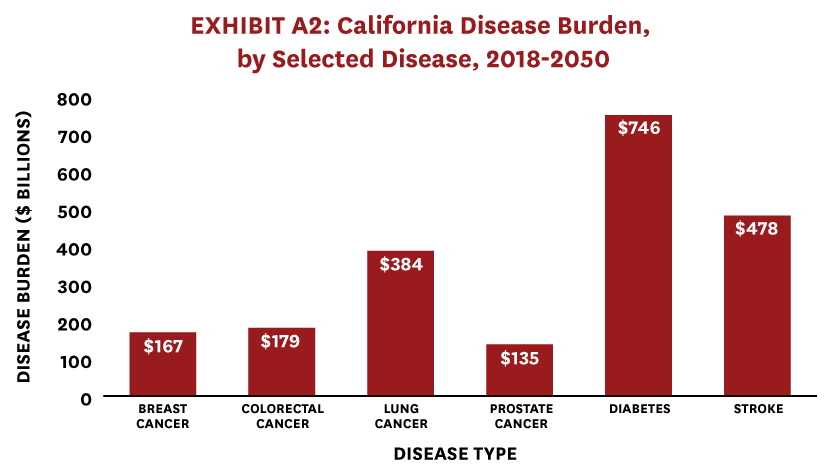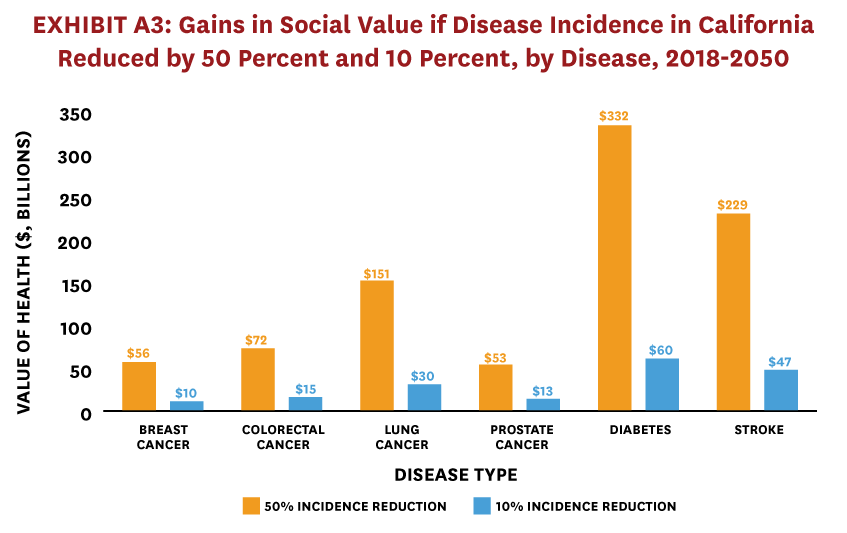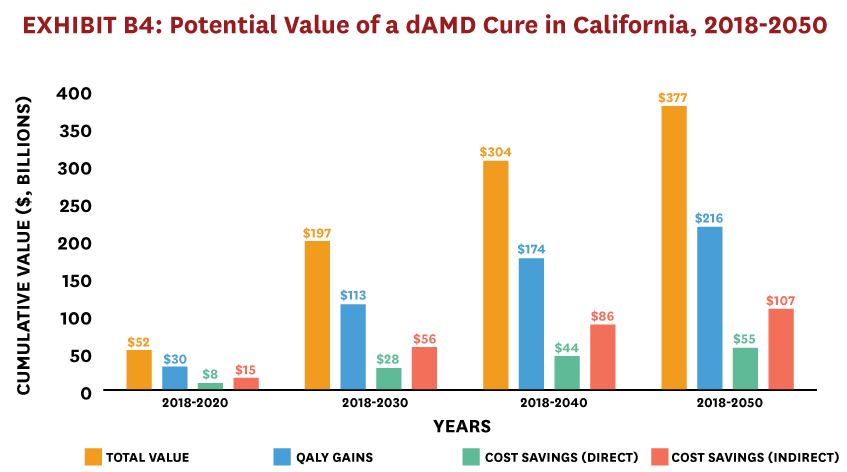A Report for the California Institute for Regenerative Medicine
Reducing the incidence of four common cancers (breast, colon, lung, and prostate cancer), diabetes and stroke by 50 percent would generate nearly $900 billion in social value for California between 2018 and 2040. Just a 10 percent decline generates $175 billion over the same period. This is according to a new analysis by researchers at the USC Schaeffer Center for Health Policy & Economics.
Commissioned by the California Institute for Regenerative Medicine (CIRM), the report estimates the value of hypothetical innovations to reduce or cure specific diseases in an effort to help the public and policymakers understand the potential of stem cell research.
CIRM was created in 2004 through a $3 billion proposition (Proposition 71) approved by California voters to finance research into curing these and other intractable diseases. Using the Future Elderly Model (FEM), Bryan Tysinger, director of health policy microsimulation at the USC Schaeffer Center, and colleagues quantified the potential return on investment if the research yielded new discoveries for high prevalence conditions as well as severe diseases.
The FEM – a sophisticated microsimulation that projects the health and economic outcomes of individuals – was adapted to reflect California’s population demographics. Social benefits are calculated using quality-adjusted life years (QALY). A QALY is a measurement used to value a year of perfect health for one individual and is used to measure cost effectiveness, benefits, and consequences of different health outcomes.
California, which is home to about an eighth of the country’s population, carries a large part of the nation’s burden for these diseases. For example, 45 percent of Californians aged 51- 52 will develop diabetes at some point during the remainder of their life. 36 percent will have a stroke and 5 to 8 percent will develop either breast, colorectal, lung, or prostate cancer. Using the FEM, the researchers predicted the burden of the selected diseases – breast, colon, lung and prostate cancer; diabetes; stroke – to reach $2.1 trillion by 2050 in California.

Note: Values are in 2018 dollars with a 3 percent annual discount rate applied.
Given, this prevalence, scientific advances that decrease disease incidence will produce significant social value. For example:
- A 50 percent reduction in diabetes in Californians 51 years of age and older would produce $332 billion in social value between 2018 and 2050.
- A 10 percent reduction results in a social gain of $60 billion during the same time frame.

Note: Social value is measured by the increase in quality-adjusted life-years (QALYs). Values are expressed in 2018 dollars using $150,000 per QALY with a 3 percent annual discount rate .
In addition to the aggregate gains for the state, lifetime per capita individual gains for single 51- or 52-year old Californian patients for the selected diseases range from $44,284 (stroke) to $467,275 (lung cancer).

Note: Values are in 2018 dollars with a 3 percent annual discount rate applied.
“Put in this context, the CIRM investment would be worthwhile if it increased our chances of success even modestly. Against the billions of dollars in disease burden facing California, the relatively small initial investment is already paying dividends as researchers work to bring new therapies to patients,” write the researchers.
Schaeffer researchers also examined the value of a cure for dry age-related macular degeneration (dAMD) for Californians, the leading cause of vision loss in the United States. The disease damages the central part of the eye’s retina, causing blurred or wavy vision, and a may cause a blind spot. The dry type is the most common form of the diagnosis and progresses slowly, but there are currently no approved treatments or cures for it.
Between 2018 and 2050 an estimated 400,000 Californians will develop dAMD and the associated vision loss, affecting their productivity and ability to live independently.
The researchers used the FEM, estimating a cure for the disease has the potential to net $377 billion in value between 2018 and 2050, with $216 billion in QALY gains, $107 billion in indirect costs and $55 billion in direct costs.

Notes: Total value is equal to QALY gains net of direct and indirect costs. Results calculated as the difference between the full population with dAMD (incident plus prevalent cohorts aged 51+ in 2018, with new incident cohorts aged 51-52 each year from 2019-2050) and a same-size population without dAMD. The value of a QALY is assumed to be $150K. All future dollar values are discounted at a rate of 3%.
Currently, CIRM funds over 50 clinical trials testing stem-cell treatments in more than 35 disease areas.
“While the course of scientific innovation twists and turns and defies easy predictions, the foresight of Californians to make stem cell research a public policy priority has positioned the state as a leader in finding new treatments for dAMD and other diseases affecting millions of people in California and beyond,” the researchers wrote in the report.
View the full report, “Future Health Dividends for California: Valuing Medical Innovations to Fight Cancer, Diabetes, Stroke, and Dry Age-Related Macular Degeneration” here.

You must be logged in to post a comment.